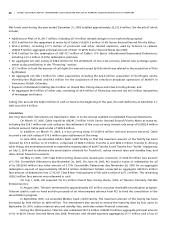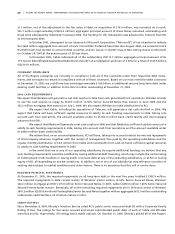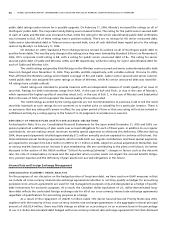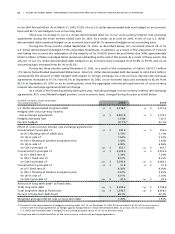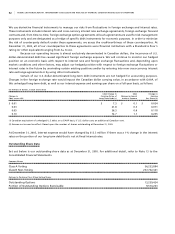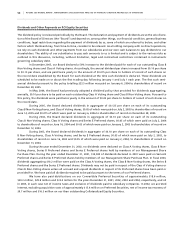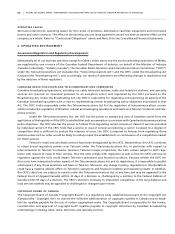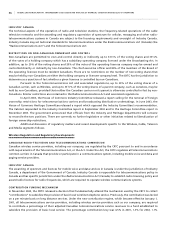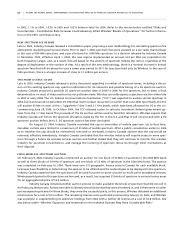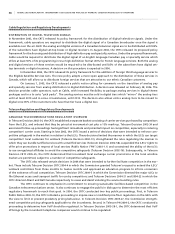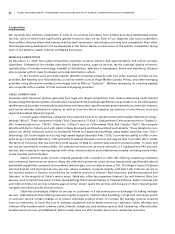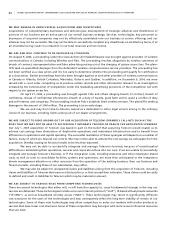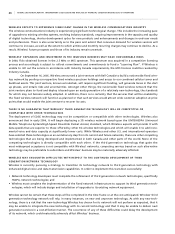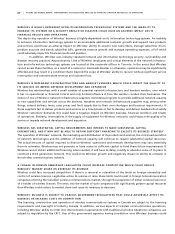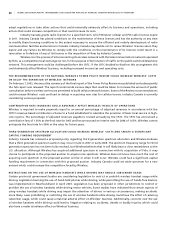Rogers 2005 Annual Report Download - page 62
Download and view the complete annual report
Please find page 62 of the 2005 Rogers annual report below. You can navigate through the pages in the report by either clicking on the pages listed below, or by using the keyword search tool below to find specific information within the annual report.
58 ROGERS 2005 ANNUAL REPORT . MANAGEMENT’S DISCUSSION AND ANALYSIS OF FINANCIAL CONDITION AND RESULTS OF OPERATIONS
Cable Regulation and Regulatory Developments
DI S T RI B UT I ON O F D IG I TA L TE L EV I SI O N S I GN A LS
In November 2003, the CRTC released its policy framework for the distribution of digital television signals. Under the
framework, cable operators are required to distribute the digital signal of a Canadian broadcaster once the signal is
available over the air. Both the analog and digital versions of a Canadian television signal are to be distributed until 85%
of the subscribers have digital set-top boxes or digital receivers. In August 2004, the CRTC released its proposed policy
framework for the licensing and distribution of high-definition pay and specialty services. Under the proposed framework,
Cable would be required to distribute the digital signal of an English language Canadian pay or specialty service which
offers at least 50% of its programming in true high-definition format (30% for French language services). Both the analog
and digital versions of these services would be required to be distributed until 85% of the subscribers have digital set-
top terminals or digital receivers. A decision on this procedure is expected in 2006.
In December 2004, the CRTC released its policy framework for the addition of foreign third language services to
the Eligible Satellite Services Lists. The new policy adopts a more open approach to the distribution of these services in
Canada, which will allow us to distribute foreign services that are attractive to our ethnic Canadian customers.
On January 7, 2005, the CRTC released a public notice calling for comments on the transition of analog pay
and specialty services from analog distribution to digital distribution. A decision was released on February 28, 2006. The
decision provides cable operators, such as Cable, with increased flexibility to package analog services in digital theme
packages and in a la carte “pick packs”. The analog services must be sold in digital tiers which “mirror” the analog tiers
until at least 2010 and in some circumstances, until 2013. The decision also allows entire analog tiers to be moved to
digital once 85% of the customers who have that tier have a digital box.
Telecom Regulation and Regulatory Developments
CA N A DI A N T EL E C OM M UN I CA T I ON S R E GU L A TO R Y O VER V IE W
In Telecom Decision 2002-34, the CRTC established a separate basket consisting of carrier services purchased by competitors
from the ILECs, and ordered that they be priced at incremental cost plus a 15% mark-up. Telecom Decision 2002-34 and
associated follow-up proceedings had significant immediate and potential impact on competitors, especially in reducing
competitors’ carrier costs. Starting in late 2002, the CRTC issued a series of decisions that were intended to enforce com-
petitive safeguards in the market in relation to the ILECs. These decisions limited the manner in which the ILECs can target
competitors’ local customers for winback (Telecom Decision 2002-73), strengthened the rules regulating the manner in
which they can bundle tariffed services with untariffed services (Telecom Decision 2002-58), suspended the ILECs’ rights to
offer price promotions in respect of local services (Public Notice (“PN”) 2003-1.1) and constrained the ability of the ILECs
to use unregulated affiliates to avoid the competitive safeguards (Telecom Decision 2002-76). Subsequently, in Telecom
Decision CRTC 2005-25, the CRTC determined that incumbent local exchange carrier promotions in the local wireline
market are permitted, subject to a number of competitive safeguards.
The CRTC also released certain decisions in 2004 that were intended to further facilitate competition in the mar-
ket. These include Telecom Decision CRTC 2004-4 in which the Commission granted Telecom’s request to extend the ILECs’
winback restrictions from three months to twelve months and approved an education program to inform consumers
of the existence of local competition; Telecom Decision CRTC 2004-5 in which the Commission directed the major ILECs to
file Ethernet access and transport tariffs for use by competitors; and Telecom Decisions 2004-21 and 2004-22 in which the
CRTC directed Aliant and Bell Canada respectively to cease and desist violating the service bundling rules.
The CRTC continues to emphasize its commitment to ensuring sustainable facilities-based competition in the
Canadian telecommunications sector. It also continues to engage the public in dialogue to determine the most efficient
regulatory framework to reach that goal. In 2004, the CRTC conducted two key public proceedings. First, in Telecom
Public Notice 2003-10, the CRTC initiated a proceeding to impose new or modified price floor regulation on the ILECs with
the view to limit or prevent predatory pricing behaviour. In Telecom Decision CRTC 2005-27, the Commission strength-
ened competitive pricing safeguards applicable to the incumbents. Second, in Telecom PN 2004-2, the CRTC conducted a
proceeding to determine how VoIP should be regulated. In Telecom Decision 2005-28-1, the CRTC determined that VoIP
offerings by the incumbent telephone companies would continue to be regulated.


